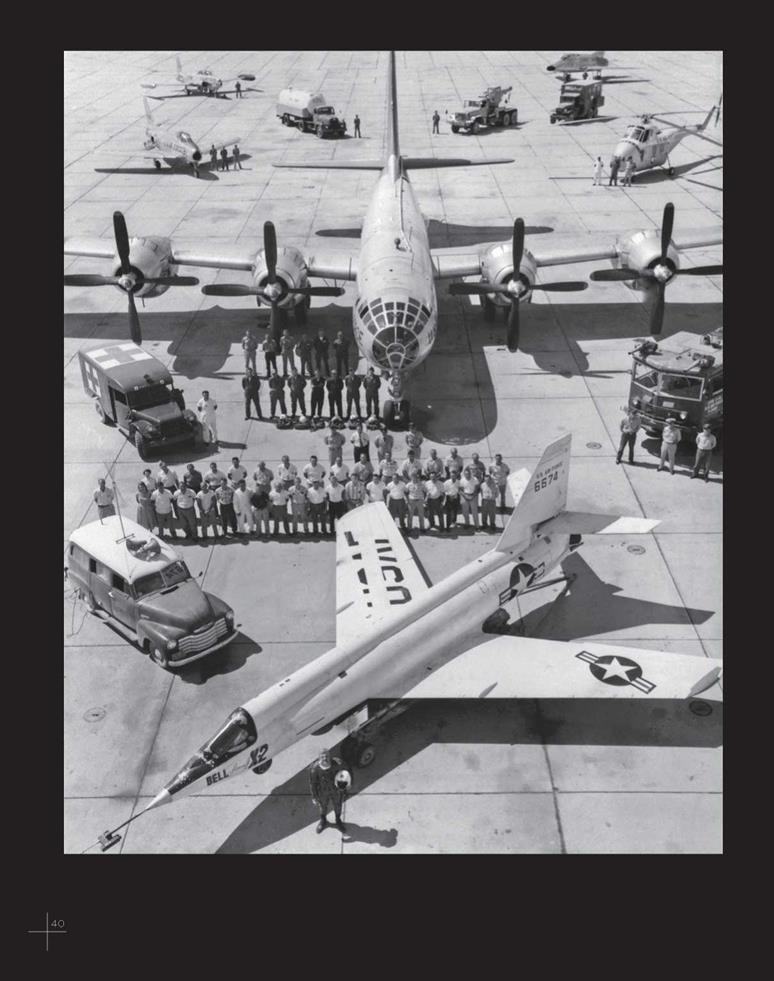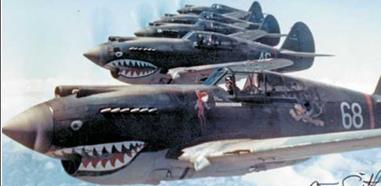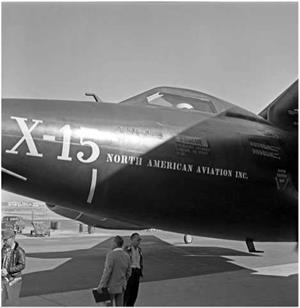THE BELL X-2
As far back as 1935, German aerodynamicist Dr. Adolf Busemann gave a paper at the fifth Volta Conference in Rome in which he introduced the swept wing as an idea for reducing the drag of supersonic airplanes. The conference topic, “High Velocities in Aviation,” was forwardlooking. At that time, the speeds of typical aircraft were in the range of 250 miles per hour, and supersonic aircraft were not yet on the radar. Busemann’s swept-wing idea was virtually ignored by the audience, an “invitation only” crowd that consisted of some of the most important aerodynamicists of the day. Ignored, that is, by everybody except the German Luftwaffe, which classified the concept in 1936—one year after the Volta Conference. During World War II,
|
X-15 mounted under the wing of the B-52 for its first captive flight. USAF, Air Force Flight Test Center Flistory Office, Edwards Air Force Base |
the Germans carried out secret, extensive aerodynamic research on swept wings, producing volumes of wind tunnel data, which was subsequently discovered by the Allied intelligence teams that went into German laboratories at the end of the war. Moreover, in 1944, R. T. Jones, one of the NACA’s best aerodynamicists, had independently proved the viability of the swept wing for reducing wave drag on high-speed wings.
This new information on swept wings, nevertheless, was too late for practical use by the designers of the X-1, who had already gone too far in the straight-wing design for the X-1.
But to compensate, the Air Force and Bell signed a new contract on December 14, 1945, for the design, development, and construction of an entirely new swept-wing X-aircraft, the X-2. This research aircraft was designed for speeds above Mach 3, which put it in the flight regime where aerodynamic heating becomes an important consideration. In fact, the investigation of aerodynamic heating at high Mach numbers was one of the principal drivers for the X-2. The skin temperature varies approximately as the square of the Mach number. Everything else being equal, the skin temperature of the X-2 (Mach 3) is nine times higher than that for the X-1 (Mach 1). This required that the X-2 be fabricated from K-monel and stainless steel alloys, rather than aluminum. Also, supersonic aerodynamics of the day dictated that an optimum supersonic airfoil shape be a thin bi-convex (circular arc) with an extremely sharp leading edge. The 40-degree swept wing of the X-2 had a thin, circular arc airfoil and an aspect ratio of 4.
Like its predecessors, the X-2 was rocket – powered. The X-2 contract included the engine, and Bell had designed for 15,000 pounds of thrust provided by two rockets, one with 5,000 pounds of thrust mounted above the other, which had 10,000 pounds of thrust. Each engine was oriented so that the thrust vector of each went through the center of gravity of the airplane. Each engine was throttleable to half, so there would be continuous thrust levels from 2,500 pounds to 15,000 pounds. The Air Force selected Curtiss-Wright, which— with Bell’s approval—took over the development of the rocket motors.
Bell Aircraft was responsible for the installation and testing of the rocket engine and for its operation during flight. Bill Smith, Bell’s chief of rocket engines, personally led these test efforts at Edwards Air Force Base, and he monitored the live static rocket testing on the ground from about 25 yards away from the airplane. (This was a far cry from modern rocket engine testing, which is conducted from concrete block houses to protect the test operators.)
 |

X-2 with its B-50 mother ship, support vehicles, support personnel, support helicopter, and chase planes. NASA Dryden Flight Research Center
The Air Force wanted to involve another company in the aircraft rocket engine business in addition to Reaction Motors, and with the agreement of

Bell, they chose Curtiss-Wright. The Curtiss – Wright Corporation was formed in 1929 from the consolidation of the Wright Aeronautical and Glenn Curtiss companies, combining the two most important aeronautical pioneers in the history of early flight in the United States. Curtiss – Wright produced the famous P-40 during World War II, the airplane that was flown by the Flying Tigers in China. After the war, Curtiss-Wright fell behind in the design of jet airplanes and phased out of the aircraft design field, taking up the production of aircraft components and simulators.
Their excursion into aircraft rocket engines, prompted by the X-2, was transitory.
The decision to go with Curtiss-Wright for the engines ultimately resulted in delays. Although Bell produced two airframes by early 1953, only one engine was available, and that not until early 1953. Ironically, one X-2 was lost due to an engine explosion that took place in the bomb bay of the B-50 carrier aircraft. On May 12, 1953, company test pilot Jean Ziegler participated in a captive test flight that was intended to qualify the liquid oxygen top-off and jettisoning system. (A captive test flight is a flight in which the airplane is carried aloft by the mother plane but never released. The X-2 remained attached to the B-50 for the entire
flight—thus the name “captive” test flight.) When the B-50 was at 30,000 feet over the center of Lake Ontario, an explosion took place. The B-50 was tossed 650 feet upward, and the X-2 disintegrated. Both Ziegler and B-50 observer Frank Wolko were lost. The B-50 immediately returned to its home base. The weather was bad, with a heavy overcast ceiling of about 10 feet. It remained bad for a week, and searches to find the two men by Bell and government aircraft found nothing.
Test flying of the X-2 continued with the second aircraft. From August 8, 1954, to September 27, 1956, a total of seventeen flights were made in
the second X-2. On July 23, 1956, with Air Force Capt. Frank Everest at the controls, the X-2 set a new unofficial world speed record of Mach 2.87. Two months later, on September 27, 1956, the X-2 made aviation history, becoming the first airplane to fly faster than Mach 3. With Air Force Capt. Milburn Apt at the controls, the X-2 set an unofficial world speed record of Mach 3.196. This was Apt’s first flight in the X-2; he flew a near-perfect flight plan to a maximum altitude of 72,000 feet and nosed over, attaining the maximum Mach number at 66,000 feet. However, Apt then put the X-2 in a slight roll, not in the flight plan. The X-2, due to inertia coupling, was unstable in roll at that Mach number and went out of control. The airplane and pilot were both lost, underscoring the dangers of test flying in unknown flight regimes.











